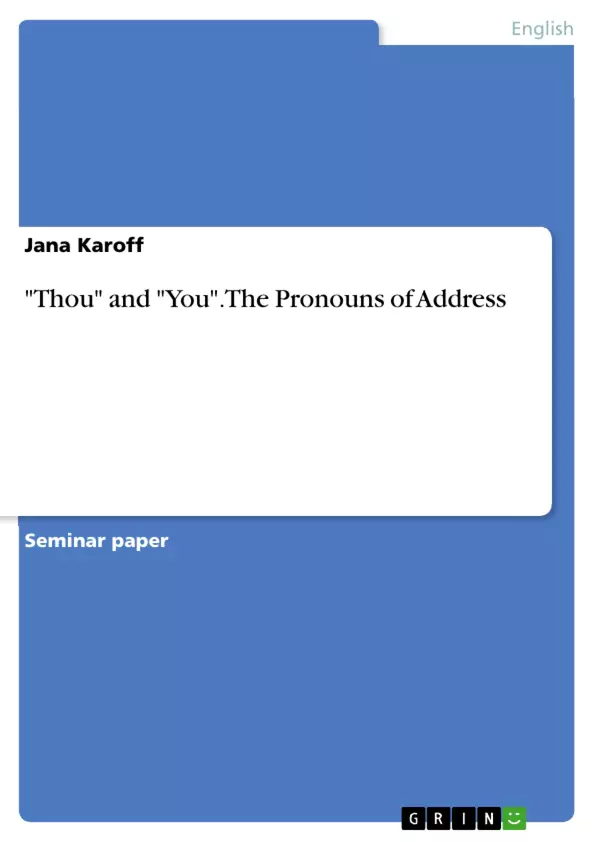The diachronic development of the English language is marked by the loss of nearly all inflections – except for the pronouns’ inflections. When comparing the Modern English pronoun paradigm to the Old English one, especially the personal pronouns are worth looking at. For a native German speaker, it stands out that in Modern English both “Du” and “Sie” are translated with only one word, you.
In English, there seems to be no distinction between familiarity and politeness in the second person pronoun. This is true for Modern English, but not for earlier forms of English. It is interesting to see that between Early Modern English and Modern English the thou, which would be translated into German as “Du”, was gradually lost and replaced by you, the former “Sie”. This paper will have a closer look at the Early Modern English distinction between thou for close personal relationships as well as differentiation between upper and lower class, and you for impersonal relationships, politeness and respect in Drama.
The following chapter will explain what a pronoun is and more precisely also define the term personal pronoun. The third chapter will introduce and contrast various values of the second person pronouns thou and you and how their use is distributed during the Early Modern English Period. In the fourth chapter, this theory will be used to analyse sections from “Hamlet” by William Shakespeare. It will take a closer look at which characters use thou and you, why they do it and what that reveals about the characters themselves and their relationship to the character they talk to. The paper will end with a conclusion about the covered theory and analysis.
Inhaltsverzeichnis (Table of Contents)
- Introduction
- The Second Person Pronoun(s) - Definition and History
- What is a pronoun? - Personal pronoun
- Old English Period - 450-1150
- Middle English - 1150- 1500
- Early Modern English – c. 1450-1700
- Modern English – c. 1700- present day
- Two theories about the usage of thou and you
- Power and Solidarity by Brown and Gilman (1960)
- Politeness theory by Brown and Levinson (1978)
- Text Analysis: Hamlet by William Shakespeare, 1601
- The Sentinels: Francisco, Bernardo and Marcellus
- The King, the Queen and the Gentlemen
- Hamlet
- Hamlet and the Ghost of his Father
- Hamlet and his Mother
- Hamlet and Ophelia
- Conclusion
- Works Cited
- Statutory Declaration and Study Skills
Zielsetzung und Themenschwerpunkte (Objectives and Key Themes)
This term paper analyzes the diachronic development of the second person pronoun in English, specifically focusing on the shift from "thou" to "you" between Early Modern English and Modern English. It examines the reasons behind this shift, exploring the interplay of social factors, politeness, and power dynamics within language. The paper utilizes William Shakespeare's play "Hamlet" as a case study to illustrate how the choice between "thou" and "you" reflected and shaped character relationships and social hierarchies in Early Modern English.
- The diachronic development of the second person pronoun in English.
- The distinction between the pronouns "thou" and "you" in Early Modern English.
- Social factors and politeness theory influencing pronoun usage.
- Power dynamics and social hierarchies reflected in pronoun choice.
- Analysis of pronoun usage in William Shakespeare's "Hamlet".
Zusammenfassung der Kapitel (Chapter Summaries)
The paper begins with an introduction that establishes the context of the study and outlines the focus on the diachronic development of the English language, particularly the second person pronoun. It then delves into a definition of pronouns and their history, tracing the evolution of the second person pronoun from Old English to Modern English, highlighting the significance of "thou" and "you" in Early Modern English. The third chapter explores two major theories that explain the use of "thou" and "you" in social contexts, namely Power and Solidarity theory by Brown and Gilman and Politeness theory by Brown and Levinson. This theoretical framework lays the foundation for analyzing the usage of "thou" and "you" in William Shakespeare's "Hamlet" in the subsequent chapter.
The fourth chapter focuses on the analysis of "Hamlet," examining the use of "thou" and "you" within specific scenes and character interactions, such as between Hamlet and his mother, Hamlet and Ophelia, and among the sentinels. This analysis aims to understand the social and psychological implications of pronoun choice in the play, revealing how Shakespeare uses language to portray character relationships, social hierarchies, and power dynamics.
Schlüsselwörter (Keywords)
The key terms and concepts explored in this paper include: diachronic linguistics, personal pronouns, second person pronoun, "thou" and "you", Early Modern English, social factors, politeness theory, power dynamics, social hierarchies, text analysis, William Shakespeare, "Hamlet," character relationships.
- Quote paper
- Jana Karoff (Author), 2014, "Thou" and "You". The Pronouns of Address, Munich, GRIN Verlag, https://www.grin.com/document/310870



